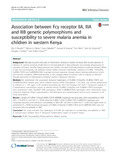Reduced Hsp70 and Glutamine in Pediatric Severe Malaria Anemia: Role of hemozoin in Suppressing Hsp70 and NF-κB Activation
Date
2016-08-30Author
Kempaiah, Prakasha
Dokladny, Karol
Karim, Zachary
Raballah, Evans
Ong’echa, John M
Moseley, Pope L
Perkins, Douglas J
Metadata
Show full item recordAbstract
Severe malarial anemia (SMA; hemoglobin [Hb] <5.0 g/dL) is a leading global cause of morbidity and mortality among children residing in Plasmodium falciparum transmission regions. Exploration of molecular pathways through global gene expression profiling revealed that SMA was characterized by decreased HSPA1A, a heat shock protein 70 (Hsp70) coding gene. Hsp70 is a ubiquitous chaperone that regulates nuclear factor-kappa B (NF-κB) signaling and production of proinflammatory cytokines known to be important in malaria pathogenesis (for example, IL-1β, IL-6 and TNF-α). Since the role of host Hsp70 in malaria pathogenesis is unexplored, we investigated Hsp70 and molecular pathways in children with SMA. Validation experiments revealed that leukocytic HSP70 transcripts were reduced in SMA relative to nonsevere malaria, and that intraleukocytic hemozoin (PfHz) was associated with lower HSP70. HSP70 was correlated with reticulocyte production and Hb. Since glutamine (Gln) upregulates Hsp70, modulates NF-κB activation and attenuates overexpression of proinflammatory cytokines, circulating Gln was measured in children with malaria. Reduced Gln was associated with increased risk of developing SMA. Treatment of cultured peripheral blood mononuclear cells (PBMCs) with PfHz caused a time-dependent decrease in Hsp70 transcripts/protein and NF-κB activation. Gln treatment of PBMCs overcame PfHz-induced suppression of HSP70 transcripts/protein, reduced NF-κB activation and suppressed overexpression of IL-1β, IL-6 and TNF-α. These findings demonstrate that SMA is characterized by reduced intraleukocytic HSP70 and circulating Gln, and that PfHz-induced suppression of HSP70 can be reversed by Gln. Thus, Gln supplementation may offer important immunotherapeutic options for futures studies in children with SMA.
URI
https://doi.org/10.2119/molmed.2016.00130https://molmed.biomedcentral.com/articles/10.2119/molmed.2016.00130
http://r-library.mmust.ac.ke/123456789/1748
Collections
- Gold Collection [1026]

